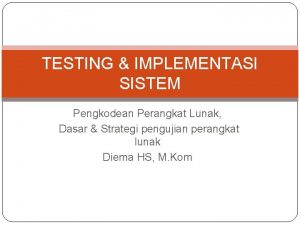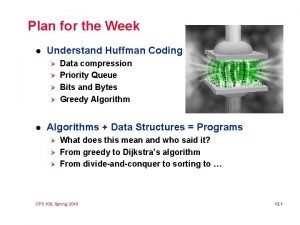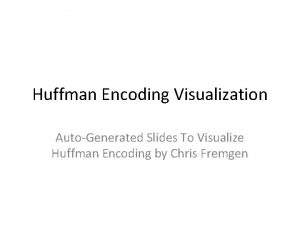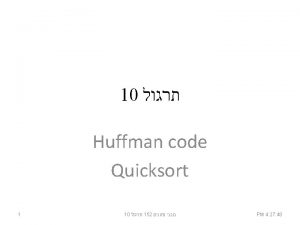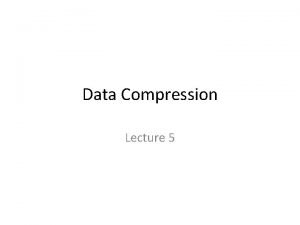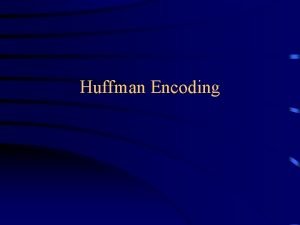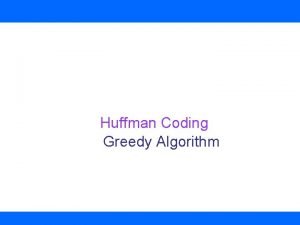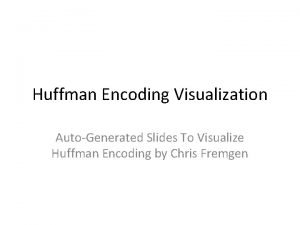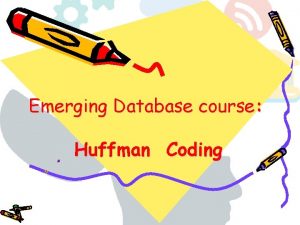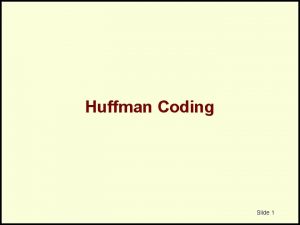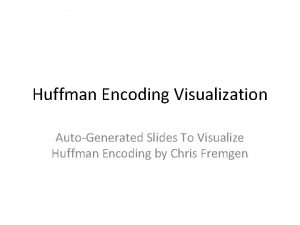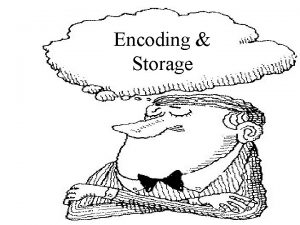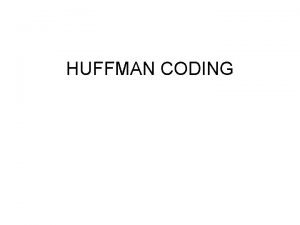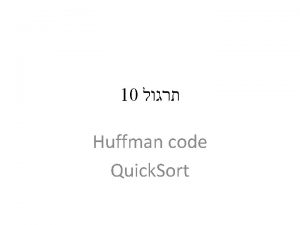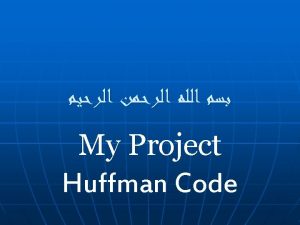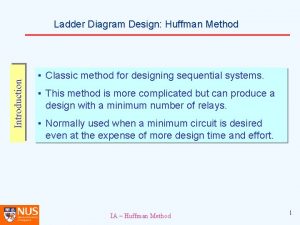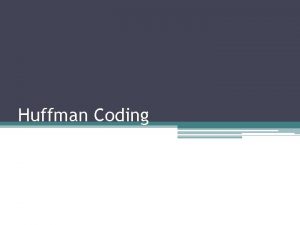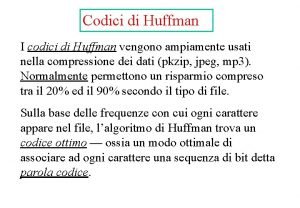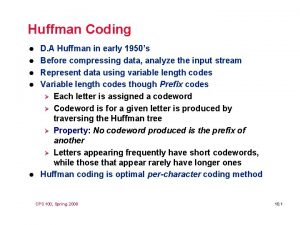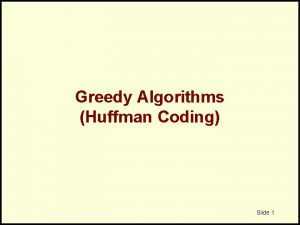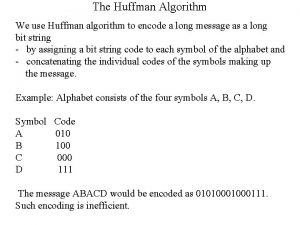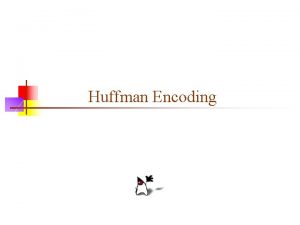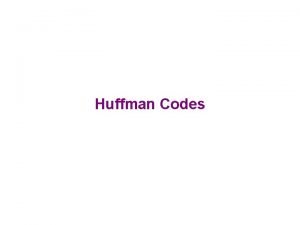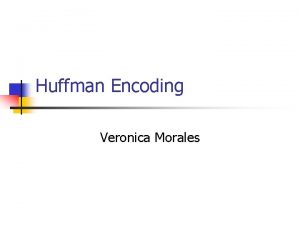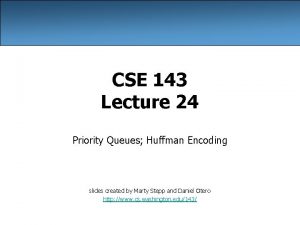Huffman Encoding Huffman code is method for the






























- Slides: 30

Huffman Encoding § Huffman code is method for the compression for standard text documents. § It makes use of a binary tree to develop codes of varying lengths for the letters used in the original message. § Huffman code is also part of the JPEG image compression scheme. § The algorithm was introduced by David Huffman in 1952 as part of a course assignment at MIT. 1

Lecture No. 26 Data Structures Dr. Sohail Aslam 2

Huffman Encoding § To understand Huffman encoding, it is best to use a simple example. § Encoding the 32 -character phrase: "traversing threaded binary trees", § If we send the phrase as a message in a network using standard 8 -bit ASCII codes, we would have to send 8*32= 256 bits. § Using the Huffman algorithm, we can send the message with only 116 bits. 3

Huffman Encoding § List all the letters used, including the "space" character, along with the frequency with which they occur in the message. § Consider each of these (character, frequency) pairs to be nodes; they are actually leaf nodes, as we will see. § Pick the two nodes with the lowest frequency, and if there is a tie, pick randomly amongst those with equal frequencies. 4

Huffman Encoding § Make a new node out of these two, and make the two nodes its children. § This new node is assigned the sum of the frequencies of its children. § Continue the process of combining the two nodes of lowest frequency until only one node, the root, remains. 5

Huffman Encoding Original text: traversing threaded binary trees size: 33 characters (space and newline) NL : 1 SP : 3 a: 3 b: 1 d: 2 e: 5 g: 1 h: 1 i: n: r: s: t: v: y: 2 2 5 2 3 1 1 6

Huffman Encoding 2 is equal to sum of the frequencies of the two children nodes. a 3 e 5 t 3 d 2 i 2 n 2 r 5 2 s 2 NL 1 b 1 g 1 h 1 v 1 SP 3 y 1 7

Huffman Encoding There a number of ways to combine nodes. We have chosen just one such way. a 3 e 5 t 3 d 2 i 2 n 2 r 5 2 s 2 NL 1 b 1 g 1 h 1 2 v 1 SP 3 y 1 8

Huffman Encoding a 3 e 5 t 3 d 2 i 2 n 2 2 s 2 NL 1 r 5 2 b 1 g 1 h 1 2 v 1 SP 3 y 1 9

Huffman Encoding a 3 t 3 4 d 2 i 2 e 5 4 n 2 2 s 2 NL 1 r 5 2 b 1 g 1 h 1 2 v 1 SP 3 y 1 10

Huffman Encoding 6 a 3 t 3 4 d 2 i 2 4 n 2 e 5 4 2 s 2 NL 1 5 r 5 2 b 1 g 1 h 1 2 v 1 SP 3 y 1 11

Huffman Encoding 8 6 a 3 t 3 4 d 2 i 2 e 5 4 4 n 2 10 9 2 s 2 NL 1 5 r 5 2 b 1 g 1 h 1 2 v 1 SP 3 y 1 12

Huffman Encoding 19 14 8 6 a 3 t 3 4 d 2 i 2 e 5 4 4 n 2 10 9 2 s 2 NL 1 5 r 5 2 b 1 g 1 h 1 2 v 1 SP 3 y 1 13

Huffman Encoding 33 19 14 8 6 a 3 t 3 4 d 2 i 2 e 5 4 4 n 2 10 9 2 s 2 NL 1 5 r 5 2 b 1 g 1 h 1 2 v 1 SP 3 y 1 14

Huffman Encoding § List all the letters used, including the "space" character, along with the frequency with which they occur in the message. § Consider each of these (character, frequency) pairs to be nodes; they are actually leaf nodes, as we will see. § Pick the two nodes with the lowest frequency, and if there is a tie, pick randomly amongst those with equal frequencies. 15

Huffman Encoding § Make a new node out of these two, and make the two nodes its children. § This new node is assigned the sum of the frequencies of its children. § Continue the process of combining the two nodes of lowest frequency until only one node, the root, remains. 16

Huffman Encoding § Start at the root. Assign 0 to left branch and 1 to the right branch. § Repeat the process down the left and right subtrees. § To get the code for a character, traverse the tree from the root to the character leaf node and read off the 0 and 1 along the path. 17

Huffman Encoding 33 0 1 19 14 8 6 a 3 t 3 4 d 2 i 2 e 5 4 4 n 2 10 9 2 s 2 NL 1 5 r 5 2 b 1 g 1 h 1 2 v 1 SP 3 y 1 18

Huffman Encoding 33 0 19 14 1 0 0 9 8 6 a 3 1 t 3 4 d 2 i 2 e 5 4 4 n 2 1 2 s 2 NL 1 5 r 5 2 b 1 g 1 h 1 10 2 v 1 SP 3 y 1 19

Huffman Encoding 33 0 1 19 14 1 0 0 9 8 6 0 1 a 3 t 3 0 4 1 d 2 i 2 n 2 s 2 0 1 4 e 5 0 1 2 NL 1 1 0 g 1 h 1 1 5 r 5 0 2 b 1 10 1 2 v 1 SP 3 y 1 20

Huffman Encoding 33 0 1 19 14 1 0 0 9 8 6 0 1 a 3 t 3 0 4 1 d 2 i 2 n 2 s 2 0 1 4 e 5 0 1 2 0 NL 1 1 0 0 g 1 1 h 1 1 5 r 5 0 2 1 b 1 10 1 2 0 1 v 1 y 1 SP 3 21

Huffman Encoding Huffman character codes NL SP a b d e g h i n r s t v y 10000 1111 000 10001 0100 101 10010 10011 0101 0110 0111 001 11100 11101 • Notice that the code is variable length. • Letters with higher frequencies have shorter codes. • The tree could have been built in a number of ways; each would yielded different codes but the code would still be minimal. 22

Huffman Encoding Original: traversing threaded binary trees Encoded: t r a v e 00111001011101010110100 1011110011110101000010010101001 1111000010101100001101111100111 0101110000 23

Huffman Encoding Original: traversing threaded binary trees With 8 bits per character, length is 264. Encoded: 00111001011101010110100 1011110011110101000010010101001 1111000010101100001101111100111 0101110000 Compressed into 122 bits, 54% reduction. 24

Mathematical Properties of Binary Trees 25

Properties of Binary Tree Property: A binary tree with N internal nodes has N+1 external nodes. 26

Properties of Binary Tree A binary tree with N internal nodes has N+1 external nodes. A internal nodes: 9 external nodes: 10 C B internal node D F E G E F external node 27

Properties of Binary Tree Property: A binary tree with N internal nodes has 2 N links: N-1 links to internal nodes and N+1 links to external nodes. 28

Threaded Binary Tree Property: A binary tree with N internal nodes has 2 N links: N-1 links to internal nodes and N+1 links to external nodes. A C B D internal link F E external link G E F Internal links: 8 External links: 29 10

Properties of Binary Tree Property: A binary tree with N internal nodes has 2 N links: N-1 links to internal nodes and N+1 links to external nodes. • In every rooted tree, each node, except the root, has a unique parent. • Every link connects a node to its parent, so there are N-1 links connecting internal nodes. • Similarly, each of the N+1 external nodes has one link to its parent. • Thus N-1+N+1=2 N links. 30
 Hardware encoding or software encoding
Hardware encoding or software encoding Go go gophers huffman coding
Go go gophers huffman coding Huffman coding visualization
Huffman coding visualization Huffman codin
Huffman codin Adaptive huffman coding
Adaptive huffman coding Huffman entropy
Huffman entropy Huffman coding method
Huffman coding method Huffman coding visualization
Huffman coding visualization Busceral
Busceral Symposium advantages
Symposium advantages Fspos vägledning för kontinuitetshantering
Fspos vägledning för kontinuitetshantering Typiska drag för en novell
Typiska drag för en novell Nationell inriktning för artificiell intelligens
Nationell inriktning för artificiell intelligens Ekologiskt fotavtryck
Ekologiskt fotavtryck Shingelfrisyren
Shingelfrisyren En lathund för arbete med kontinuitetshantering
En lathund för arbete med kontinuitetshantering Särskild löneskatt för pensionskostnader
Särskild löneskatt för pensionskostnader Tidbok för yrkesförare
Tidbok för yrkesförare A gastrica
A gastrica Densitet vatten
Densitet vatten Datorkunskap för nybörjare
Datorkunskap för nybörjare Stig kerman
Stig kerman Att skriva debattartikel
Att skriva debattartikel Delegerande ledarskap
Delegerande ledarskap Nyckelkompetenser för livslångt lärande
Nyckelkompetenser för livslångt lärande Påbyggnader för flakfordon
Påbyggnader för flakfordon Tryck formel
Tryck formel Svenskt ramverk för digital samverkan
Svenskt ramverk för digital samverkan Jag har nigit för nymånens skära
Jag har nigit för nymånens skära Presentera för publik crossboss
Presentera för publik crossboss Jiddisch
Jiddisch
